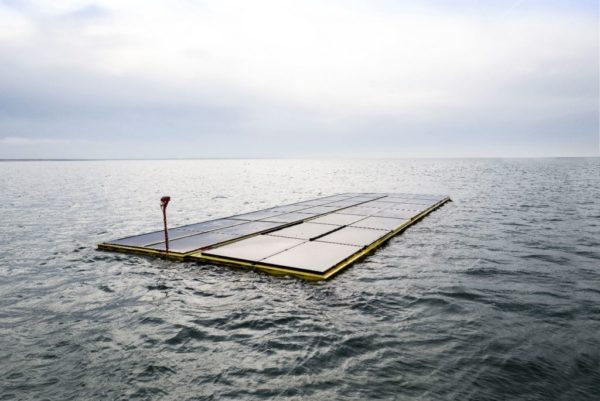Netherlands-based start-up Oceans of Energy has unveiled a few details of the first 18 months of operation of its 50 kW off-shore pilot PV project in the North Sea.
“It has weathered all the storms since November 2019, and these were many!” the company's CEO and founder, Allard Van Hoeken, told pv magazine. “Including the storms named Ciara, Dennis, Bella, Evert.” The installation had to deal with waves as high as 10 meters, wind speeds of up to 62 knots, and tidal currents of up to 4 knots.
“We have tested multiple solutions for key challenges, and we have seen what works well and what doesn’t,” Van Hoeken added. “Overall, the system has remained in good condition.” He also explained that the achieved results encouraged the company to start the fabrication of the units in order to expand the system to up to 1 MW, with the design remaining unchanged.
“Solar power generation was until now not the major focal point, since our focal point was the structural well-being of our system in the high waves, winds and currents, but solar production was monitored and was in line with what we expected,” the CEO further explained, noting that, in the project's next phases, power production monitoring will be a major focal point.
“We are measuring everything we can, including loads, movements, power production, regular observation and inspection of practically all components, also ecological parameters such as light in the water, water quality parameters such as temperature, turbidity chlorophyll, oxygen levels, and salinity,” he added. “We take sediment samples as well as water sampling for fish eDNA and phytoplankton. We also observe the interaction of our platforms with life at sea, such as which plants and animals like to attach underwater to the bottom of our platforms.”

Image: Oceans of Energy
The 50 kW modular PV system started operating at the end of November 2019. The plant is planned to be initially expanded to 1 MW, and to 100 MW at a later stage. The installation relies on standard solar modules.
Van Hoeken said in December 2019 that solar at sea could end up being cheaper than offshore wind, once the technology is scaled up. He believes that offshore PV could help the Netherlands cover 50% of its energy demand, mainly by deploying solar close to existing or planned offshore wind projects.
According to a recent report from DNV GL, the North Sea may host around 100 MW of floating solar capacity by 2030, and 500 MW by 2035. The LCOE of offshore PV systems is currently estimated at around €354/MWh but in the future it should be close to that of ground-mounted solar parks.
The DVN GL experts are convinced that offshore PV is ideal as a complementary technology of offshore wind, with solar panels being installed in the space between the wind turbines and connected to their transmission lines.
Scientists from the Copernicus Institute at Utrecht University in the Netherlands have claimed offshore PV plants could be more productive than ground-mounted arrays after running a simulation comparing a North Sea project to a conventional system at the Utrecht Photovoltaic Outdoor Test field.
*The article was updated on July 16 to reflect that the current capacity of the PV system is 50 kW and not 8.5 kW, as we previously reported.
This content is protected by copyright and may not be reused. If you want to cooperate with us and would like to reuse some of our content, please contact: editors@pv-magazine.com.




3 comments
By submitting this form you agree to pv magazine using your data for the purposes of publishing your comment.
Your personal data will only be disclosed or otherwise transmitted to third parties for the purposes of spam filtering or if this is necessary for technical maintenance of the website. Any other transfer to third parties will not take place unless this is justified on the basis of applicable data protection regulations or if pv magazine is legally obliged to do so.
You may revoke this consent at any time with effect for the future, in which case your personal data will be deleted immediately. Otherwise, your data will be deleted if pv magazine has processed your request or the purpose of data storage is fulfilled.
Further information on data privacy can be found in our Data Protection Policy.